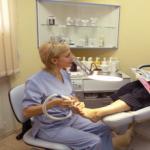Learning to read labels: What should not be in creams, toothpaste and shampoos. What should not be in detergents What should be in cosmetics
How to choose the right washing powder for yourself so as not to harm your baby? What are organic and non-organic dishwashing detergents? What can I use instead of a floor cleaner to avoid using chemicals at all? A specialist answers these and other questions.
Ekaterina Yusupova, ecoblogger (amelyrain.eco) with higher environmental education
Floor cleaner

— It is especially important to choose a safe floor cleaner for those who have children. After all, crawling on the floor, babies collect the remnants of this product with their hands and then put their hands in their mouths. Therefore, the safer and more environmentally friendly the chosen packaging, the better.
What should not be included:
— Ethoxylated surfactants. They can be hidden under the designations: A-surfactants (anionic surfactants or - another name - A-tensides), nonionic surfactants. Most of these substances are obtained through petrochemical reaction chains. They are aggressive and dangerous to health.
Hexylcinnamaldehydes are a potential allergen. Another unwanted allergen is limonene. It can trigger asthma.
— It is better to choose products based on plant and sugar surfactants. But their concentration should be within 5-15%. As for preservatives and fragrances, you should pay attention to detailed information.
If there is no clarification on specific ingredients and percentages, most likely toxic synthetic ones are used.
For example, soap nuts (a natural detergent that is sold in eco-shops - I.R.'s note), natural laundry soap (the usual one is very aggressive, smells bad, but has a natural composition), soda. You can add tea tree oil to the water for washing floors. It has excellent bactericidal properties.
Dishwashing liquid

Inorganic
The main ingredient of such detergents is surfactants (surfactants), which remove contaminants from the surface. However, they have a negative effect on the human body. They contribute to premature aging of the skin, increase the risk of heart attacks and strokes, and cause allergies.
Surfactants exist in four types:
anionic- cheap and effective, but the most dangerous to health. They can accumulate in the body and cause various diseases, for example, liver, heart, kidneys;
cationic - less toxic and have bactericidal properties, but cope less well with pollution;
amphoteric - can act on the body as cationic or anionic surfactants depending on the environment (acidic or alkaline);
non-ionic (non-ionic)- safer substances because they completely decompose during dishwashing. But they can also be ethoxidized.
To reduce the negative impact of surfactants (primarily anionic ones), it is better to choose products in which their content does not exceed 5%.
Foaming directly depends on the amount of surfactants in it: the better the detergent foams, the more of these substances it contains.
Natural eco-friendly
These detergents are based on substances of plant origin that completely decompose during the washing process. Such products are safe for health: they do not corrode the skin, are completely washed off from the surface of the dishes, and do not cause allergies.
— Dishwashing detergents should not contain ethoxylated surfactants, dangerous preservatives (phenoxyethanol, katon), or synthetic azo dyes.
In addition to surfactants, inorganic detergents also contain other harmful substances, such as phosphates or (phosphonates), chlorine, alkalis, and triclosan.
Which, on the contrary, is welcome
Natural dyes can be designated in the composition as follows: Cl 77….
Toilet (sometimes bathtub) cleaner

It is better not to choose a universal product that is suitable for both the bathroom and the toilet. Each of these rooms is ideally cleaned with its own product.
Most toilet bowl cleaners contain:
- Surfactants that break down contaminants.
- Acid to remove rust and enhance the action of surfactants.
- Alkali as a solvent for fatty deposits and organic blockages, partially eliminating plaque and rust.
- Chlorine for disinfection and subsequent elimination of unpleasant odors.
What should not be included
It is better not to choose a product with chlorine. This is a toxic substance. It can cause difficulty or rapid breathing, chest pain, coughing, eye irritation, increased heart rate, and even death.
Which, on the contrary, is welcome
Fortunately, safe disinfectants using natural essential oils have long been invented.
What can you choose instead of a special product?
— Place 30 grams in a bowl of warm water laundry soap , add a tablespoon of shampoo, shake. Rub the bath or toilet thoroughly with this soapy water, leave for about thirty minutes, then rinse.
Powder or gel for washing

— A common mistake parents make is the opinion that only children need the best and eco-friendly things. We forget that babies come into contact with our clothes, for example, during hugs, play... If our powder consists of critical ingredients, most of which are not rinsed with water, but accumulate in the fabrics, then this will harm not only our health, but also the health of children. It is especially dangerous when it comes to allergy sufferers.
What should not be included
A-surfactant content above 15% is undesirable. The composition should also be free of enzymes and zeolites, as they can be of low quality and then be harmful to health. Such substances are allowed only if the product has the highest level of eco-certificate, for example, Ecogarantie.
Preservatives and fragrances are also undesirable, because they are often synthetic and harmful not only to allergy sufferers, but also to ordinary people.
There should be no phosphates, phosphonates, or optical brighteners.
Which, on the contrary, is welcome
It is better if the surfactants are herbal or sugar. Oxygen bleaches are also safe.
Tile cleaner

What should not be included
When using such products, it is better to use gloves and choose an A-surfactant content of less than 15%.
What can you choose instead of a special product?
Ordinary table vinegar has a fairly effective cleaning effect. They are easy to clean using a spray bottle. We take a bottle equipped with a spray bottle and pour table vinegar into it. When working with vinegar solution, you should protect your hands by wearing rubber gloves.
The specialist adds: the high price and popularity of a product do not always indicate its safety. If a product has a strict international eco-certificate, it usually costs more. This is explained by the fact that certification is a rather expensive thing, and besides, such a product usually uses the best and most expensive ingredients, often of organic origin. instead of cheap synthetic ones.
— If you choose safe, eco-natural chemistry, then protective equipment is optional. However, in the case of using aggressive products from mass market shelves, protection is necessary on all fronts. For example, a mask (if the product is a spray or contains chlorine) and gloves.
A lot has been said about the benefits of chocolate. This delicious cocoa product improves mood, gives a boost of vivacity and energy, and contains many microelements that are necessary for the normal functioning of the nervous system. True, there is a small “but”: chocolate is healthy if it is made from high-quality raw materials and stored correctly. How to distinguish high-quality chocolate from a low-quality product?
Signs of good chocolate
Let's look at the packaging
The first signs of good chocolate are immediately noticeable: these are the ingredients in the product. Under the guise of chocolate, they may not be selling what you are looking for, but an ordinary confectionery bar, which is a mixture of different components that vaguely resemble chocolate.
Criteria for choosing quality chocolate:
- To choose good, tasty chocolate, you need to know what its ingredients are: pay attention to which ingredient comes first in the composition. It is this that is the basic component;
- the ingredients are indicated in the composition based on the dosage of each component: from most to least;
- good chocolate leaves a pleasant tart aftertaste;
- the high cost of each tile (cocoa butter is an expensive product);
- shelf life - up to six months;
- storage temperature is about 18 degrees.
These are the key features and characteristics of good chocolate. They are, in fact, based on the most important basis: composition.
What should be included?
How to choose good chocolate and how to distinguish it from a cheap confectionery bar? The hallmarks of good chocolate are its detailed composition and the presence of the following ingredients:
- cocoa butter (as one of the main ingredients);
- lecithin (a trace element that provides energy and improves memory, is part of brain cells and tissues);
- grated cocoa;
- sugar (powdered sugar);
- glossy surface (polished);
- When a tile breaks, a dry crack is heard.
What should not be included?
- confectionery fat (coconut, palm, cottonseed oil);
- cocoa butter equivalents or substitutes;
- emulsifiers;
- cocoa powder (cocoa vella);
- matte tile surface;
- When the tile breaks, a dull sound should be heard.
How much chocolate is healthy?
The norm for an adult is up to 30 grams per day. It is best to consume chocolate in the morning, no more than twice a week. This is especially true for children. If you enjoy chocolate at night, you may experience difficulty falling asleep and increased nervous excitability.

Which chocolate is the healthiest?
In this situation, the answer is clear: dark chocolate provides more health benefits. It contains a maximum of grated cocoa and cocoa butter, a minimum of sugar and milk impurities. But, if you love milk and white chocolate, you shouldn’t deny yourself this pleasure. The main thing is that they contain grated cocoa (for milk) and natural cocoa butter (for milk and white).
Taking these features into account, you can choose high-quality chocolate that will be healthy, taste good and give you pleasant moments of enjoying a delicious dessert.
Challenger decided to figure out what components are included in the face cream and how they affect the skin. We will figure it out with the help of a professional dermatologist, of course.
Irina Kotova
What does face cream consist of?
The ingredients typically found in face cream (non-organic) can be divided into several main groups. Firstly, these are biologically active substances, they influence skin cells in a certain way depending on the purpose of the cream - anti-aging, moisturizing, restoration. The second important group is emulsifiers; they stabilize the cream base, the emulsion, which is water mixed with oil. Emulsion is used most often, as it allows biologically active components to be more easily absorbed into the skin tissue. But there is a very important point: the oil must be natural (almond or olive). Alas, mineral oil, which is a liquid extract from petroleum products, is most often added to cosmetic products. Preservatives also play an important role, because thanks to their antibacterial and antifungal effect, in most cases they prevent the risk of microbial growth in the cream and prolong its shelf life. And finally, fragrances give the cream a pleasant smell, but since they are most often the catalysts for allergic reactions, people with sensitive skin should choose fragrance-free creams.

The cream may contain potentially carcinogenic substances, since most of them are stabilizers and UV filters. Their concentration is strictly regulated and in any case should always remain minimal. But chemicals such as dioxane and phthalates are poisonous and dangerous to humans and should be avoided even in small quantities.
It is based on these facts that you should pay attention to the composition of the cream. Thus, the first components of the composition determine its properties and actual purpose.
- Moisturizing cream: glycerin, water, hyaluronic acid, collagen, elastin, urea, lactic acid.
- Anti-aging cream: retinol, vitamins A, E, C, coenzyme Q10, alpha lipic acid, peptides, DMAE (dimethylaminoethanol).
- Regenerating cream: ceramides, lilac and lanolinic acids, phosphatidylcholine (lecithin), centella asiatica extract, horse chestnut extract, panthenol, aloe vera extract.
- Cream for problem skin: salicylic acid, azelaic acid, AHA acids (alpha hydroxide), triclosan, retinoids, copper, zinc, sulfur, talc, clay, niacinamide.
Interestingly, the compositions of day and night creams are not very different from each other. The main difference is the texture: the night one is lighter. Water-protective filters are added to the cream for daytime use, and on the contrary, for nighttime use, ingredients that cannot be used in combination with ultraviolet radiation: AHA acids (phytic and kojic), arbutin, glabridin and retinoids in high concentrations.

How each component of the cream affects the skin
Cetyl, Stearyl, Cetearyl Alcohol(cetyl, stearyl, cetearyl alcohols) and Propylene glycol(propylene glycol): transport substances that promote deeper penetration of active substances deep into tissues. Only alcohol dries the skin, and propylene glycol, on the contrary, softens and moisturizes.
Triclosan(triclosan): an antibacterial substance that is used as an anti-inflammatory component.
Triethanolamine (TEA)(triethanolamine): surfactant, stabilizer necessary for the cream to look like a coherent structure and not separate into water and oil.
Butylated Hydroxyanisole (BHA)(butylhydroxyanisole) and Butylated Hydroxytoluene (BHT)(butylated hydroxytoluene): chemical antioxidants that are used as preservatives.
Phthalates (DBP, DEP)(phthalates): stabilizers that give the cream a special softness. Substances that are toxic to humans can cause the development of cancer.
Preservatives(preservatives) and Parabens(parabens): substances that prevent the proliferation of microorganisms (bacteria) in the cream, preventing the development of skin diseases.
Fragrance(flavors): fragrances, aromatic substances that give the cream a certain smell. As a rule, the natural components of the cream do not smell very pleasant.
Glycerin(glycerin): a moisturizing component that has earned its popularity for its ability to supply water from the lower layers of the skin to the surface. Glycerin also helps maintain and preserve the top protective layer of skin cells.
Mineral oil(mineral oil): oil protects the skin from moisture loss. The film created on its surface slows down the evaporation of water, making the skin look more hydrated and smooth.
Urea(urea): a natural ingredient that is added to moisturizer.
Hyaluronic Acid(hyaluronic acid): a natural substance that is part of epithelial and connective tissues, improves the structure of the epidermis, moisturizes and softens the skin.
Collagen(collagen): the most important protein of the connective tissues of the body. The cream has smoothing and moisturizing effects.
Ceramide(ceramides): fatty acids that are capable of repairing damage to the intercellular structure caused by skin diseases and external influences.
Lecithin(lecithin): a nutrient that makes the skin soft and helps biologically active components penetrate deep into the epidermis.
Retinol(retinol): fat-soluble vitamin A, helps combat age-related skin changes. When added in high concentrations to anti-aging creams, retinol can cause redness and irritation.
Coenzyme Q10(Coenzyme Q10): An antioxidant that stimulates collagen synthesis and protects skin cells from premature aging.
Elastin(elastin): a protein - a relative of collagen, responsible for the firmness and elasticity of skin tissue.
Nicotinamide(niacinamide): vitamin B3, which fights acne marks and evens out skin tone, making it brighter.
Dimethylaminoethanol (DMAE)(dimethylaminoethanol): a chemical compound that is added to almost any anti-aging cream. Its effects have not yet been fully studied, but there are reports that indicate that the use of dimethylaminoethanol leads to the death of skin cells.
Our skin can absorb up to 60% of what we put on it. Together with our favorite cream or facial wash, we can feed our body daily with a dose of parabens and carcinogens. With the help of experts we trust, we tried to figure out which ingredients should not be present in our cosmetics, and which, on the contrary, will only add benefits to us.
“Nothing will make you more wary of any chemical that comes near you than the doctor telling you: “You have cancer.” This is exactly what happened to me,” after learning about her illness, Gillian Decon completely reconsidered her attitude towards cosmetics and wrote the book “There’s Lead in Your Lipstick: Toxins In Our Everyday Body Care And How To Avoid Them,” which became a bestseller in the USA and Canada (“Lead in Your Lipstick: Toxins in the Cosmetics We Use Every Day and How to Stay Away from Them.”)
Gillian highlights 20 ingredients to stay away from. Many of them have long been banned for use in Europe, but not in North America, where the author is from.
1. Coal tar. A known carcinogen that is banned in Europe but is still used in North America. Used in creating treatments for dry skin and anti-dandruff shampoos. Often hidden behind the FD&C Red No labeling. 6. In addition to carcinogenic effects and acute allergic reactions, it can cause asthma attacks, chronic fatigue, headaches and nausea.
2. DEA/TEA/MEA. Surfactants (surfactants). These carcinogens are used in shampoos, soaps and shower gels. Irritates eyes, skin and mucous membranes, causing dermatitis. Diethanolamine (DEA) easily penetrates the skin and is deposited in various organs, especially the brain. Substances in this group are toxic to the kidneys, liver, brain and skin.
3. Ethoxylated surfactants and 1,4-dioxane. Never appears on the label, but is found in 57% of baby detergents in the US. Long-term contact may cause irritation of the skin, mucous membranes of the eyes and nasopharynx.
4. Formaldehyde. Added to nail polishes, hair dyes, shampoos. Banned in Europe. Extremely toxic. Causes severe irritation of the mucous membrane, dermatitis.
5. Synthetic flavors. Hidden chemicals. May cause headaches, dizziness, asthma and allergies.
6. Hydroquinone. Used in facial whitening products. May contribute to the development of cancer and reproductive dysfunction.
7. Lead acetate. A known carcinogen that can be found in lipsticks and hair dyes in the United States. It is not indicated on the label. Banned in Europe. Has a toxic effect on the liver, kidneys and nervous system.
8. Mercury. A known allergen that can cause brain dysfunction. Found in some mascaras and eye drops.
9. Mineral oil. A petroleum product often used in baby oils, moisturizers and hair styling products. Creates a film on the skin that prevents the natural removal of toxins from the body. May reduce the protective function of the skin.
10. Oxybenzone. Active ingredient in sunscreens. Causes allergies and hormonal dysfunction.
11. Parabens. Trade name: butylparaben, ethylparaben, methylparaben, propylparaben. In cosmetics they are often used as a preservative. Causes dermatitis and allergies. May be one of the causes of tumor diseases.
12. Paraphenylenediamine (PPD). Used in hair products, but is toxic to the skin and harms the immune system.
13. Phthalates. Banned in Europe. They have a negative effect on the reproductive system, including infertility, and can cause cancer, dysfunction of the liver, kidneys and lungs. Found in some nail polishes, perfumes, deodorants, and hair sprays.
14. Placental extract. Used in anti-aging products, as well as in hair care cosmetics. May negatively affect the health of the endocrine system.
15. Polyethylene glycol (PEG). Penetrates into the deep layers of the epidermis and delivers other harmful carcinogens there.
16. Silicone emulsifiers. Used to achieve a soft consistency of the product. It is not biodegradable and does not allow the skin to breathe. They have been linked to tumor growth and skin irritation.
17. Sodium Laureth Sulfate (SLES) - sodium laureth sulfate and Sodium Lauryl Sulfate (SLS) - sodium lauryl sulfate. In the past, industrial degreaser was often used in the production of soap formulas. It gets absorbed into the skin and causes irritation.
18. Talc. Used in baby powder, eye shadow, blush and deodorant. It is associated with tumor and respiratory diseases.
19. Toluene. Used in nail and hair products. Often hidden behind the Parfum/Fragrance label. Negatively affects the immune system and endocrine system.
20. Triclosan. Most often found in antibacterial products and deodorants. Irritating to the skin, toxic to the body and negatively affects the liver, kidneys, lungs and brain.
✭ Gillian herself began not only to carefully read labels and choose organic cosmetics, but also to make them herself: “When you prepare a mask or toner yourself, you know exactly what ingredients you are using. It may seem stupid and too complicated, but I encourage you to try it. While writing the book, I prepared many creams, masks and lotions and gladly tested them on myself and my friends. Nothing makes me happier than when I see how well a product I mixed with my own hands works.”
・ ・ ・
Katerina Karpova, creator of the natural cosmetics brand Pure Love
- What should you be wary of in cosmetics?
“This is a group of substances whose names contain PEG or PGG (Polyethylene glycol and Polypropylene glycol), fatty alcohols ending in -th or “-et” Laureth-9, Polysorbate (polysorbates), Polaxamer (polaxomers), Sodium Laureth Sulfate (Laureth sulfate sodium) - all these substances can disrupt the barrier function of the skin. It is also worth paying attention to Propylene Glycol (propylene glycol) and Butylene glycol (butylene glycol) at the beginning of the composition - in large quantities they are potential irritants and can affect skin sensitivity.
Alcohol or Alcohol Denat (ethyl alcohol) at the top of the list helps dry out the skin. Some chemical filters behave the same way, for example, Oxybenzone (oxybenzone), Octyl Methoxycinnamate or Octinoxate (octinoxate), Octocrylene (octocrylene). All these substances can penetrate into the deep layers of the skin and also oxidize during prolonged exposure to the sun. Organic products are often simple in composition, you will see vegetable oils, fatty alcohols, flower waters, extracts, proteins, physical sunscreens Titanium Dioxide, Zinc Oxide and acids as a preservative.
Natural products do not contain the red flag ingredients described above, silicones, ingredients ending in -con, -conol, -xan-, such as Dimeticone, Cyclomethicone or Cyclopentasiloxane, and mineral oil.”
・ ・ ・
Ingredients that will improve your skin
“It’s good if day creams contain balanced oils, for example, Argania spinosa Oil (argan), Oryza Sativa (Rice) Bran Oil (rice bran oil) or Baobab Seed Oil (baobab oil). As an additional option - grape oil. Particularly valuable in night remedies are Oenothera biennis (Enotera), Evening Primerose Oil (Evening Primrose), Rosa canina Oil (rose hips) and Borago officinalis L. Oil (Borago, borage oil). These oils replenish the deficiency of essential linoleic and linolenic fatty acids in the skin, which actively participate in the life of the skin, maintaining its healthy appearance.
Dry, problematic and sensitive skin needs ingredients that help restore the protective barrier of the epidermis. These include Ceramide (ceramides), Lecithin, Phosphatidylcholine (lecithin), NMF (NUF or Natural Moisturizing Factor), Phytosterols (phytosterols), Lactobacillus or Bifidobacterium lysate, Galactoarabinan, Inulin (prebiotics). The skin also needs antioxidants, some of the most famous are Camellia Sinensis Leaf Extract (green tea), Vitis vinifera Extract (grape extract), Centella asiatica Extract (Asian centella, gotu kola). It is important that the pH of the cream is balanced and close to our natural Ph 5.5. This may be indicated by the presence of lactic acid (lactic acid) or citric acid (citric acid) at the end of the composition.
・ ・ ・
Dull complexion- this is a sign of poor circulation, so look on the label for ingredients that will strengthen it: grape extract, green tea, centella asiatica or the strongest antioxidant - superoxide dismutase (SOD) and licorice extract. For heavy smokers, I recommend products containing blueberry and hibiscus extract - they refresh the complexion.
For UV protection SPF products that contain chemical filters are not suitable for daily use. Look for minerals: titanium dioxide or zinc oxide. Milk thistle extract, mate tea and ratania root also protect against ultraviolet radiation and help skin cells stay healthy.
To restore the skin's protective barrier Ceramides (the main elements of the lipid structure of the upper layers of the skin), lecithins, blackcurrant oil, macadamia oil, amaranth extract help - they all contribute to the rapid restoration of the skin.”
・ ・ ・
And a few more tips:
When choosing a product, first study the order in which the ingredients are in the composition. Those at the beginning of the list are in larger quantities, and those towards the end are in smaller quantities.
If you come across some unknown ingredient on the list on the label, check its origin on the Ekokosmetika website or in the Skin Deep database.
Choose cosmetics whose environmental friendliness is proven by ECOCERT, BDIH, NaTrue, Cosmebio, USDA Organic and other certificates. We talked about the brands of organic cosmetics that we especially love.
The greatest attention should be paid to the composition of those products that we use daily and that remain on our skin for a long time: tonics and lotions, face creams, sunscreen, deodorants and oils. If the product only comes into contact with the skin for a short time and is washed off (for example, hand soap), you don’t have to worry so much about its composition.
Material half prepared: Nastya Khvatova
Whose blog is dedicated to analysis of ingredients, we find out how to determine whether a particular product is really safe for children.
Already at the very beginning of pregnancy, many expectant mothers think about what care products they will use for their babies. And they are starting to choose their care more carefully.
And this is right, because mother and child need the most gentle, safe care. Especially when the baby is born.
The thing is that children's delicate skin is much thinner than an adult's. Because of this, it is especially permeable; any substances from cosmetics and the surrounding world get inside much faster. In addition, the baby’s skin does not yet have such functions as to provide him with complete protection from substances from the outside world.
That is why when using any cosmetic products you need to pay special attention to their composition. Unfortunately, the inscription “for children” does not always mean that the product will not cause harm.
In this article I will give a useful cheat sheet that will help you navigate the compositions. So, let's go!
Such components can be divided into three groups:
- completely prohibited in children's cosmetics (in the EU)
- unwanted Ingredients
- dangerous for allergy sufferers
1. Prohibited ingredients in children's cosmetics (in the EU)
- Methylisothiazolinone and methylchloroisothiazolinone (in leave-in cosmetics)
- Propylparaben, butylparaben (in baby diaper cosmetics)
- Isopropylparaben
- Isobutylparaben
- Phenylparaben
- Benzylparaben
- Pentylparaben
- Benzophenone-1
- Benzophenone-2
2. Undesirable ingredients in children's cosmetics
- Mineral oil and its derivatives clog pores, creating a “greenhouse effect” that makes the skin drier over time
- PEG derivatives - make the skin thinner and more permeable to other substances
- Silicones - act like mineral oil. This is a substance foreign to the skin that cannot restore it in any way.
- Sodium Laureth Sulfate is a strong surfactant that degreases the skin and leads to dryness.
- All ingredients with MEA, DEA, TEA in the name
- All parabens have a hormonally similar effect
- Critical UV filters: Benzophenone-3, Benzophenone-4, Benzophenone-5, 4-Methylbenzylidene Camphor, Homosalate, Octocrylene, Octyl Methoxycinnamate
3. Particularly allergenic ingredients
Alpha-isomethyl ionone, Amyl cinnamal, Amylcinnamyl alcohol, Anise alcohol, Benzyl alcohol, Benzyl benzoate, Benzyl cinnamate, Benzyl salicylate, Butylphenyl methylpropional, Cinnamal, Cinnamyl alcohol, Citral Citronellol, Coumarin, Eugenol, Evernia furfuracea extract, Evernia prunastri extract, Farnesol , Geraniol, Hexyl cinnamal, Hydroxycitronellal, Hydroxyisohexyl 3-cyclohexene carboxaldehyde, Isoeugenol, Limonene, Linalool, Methyl 2-octynoate.
Such ingredients should be avoided by children with or prone to allergies.
Essential oils should also be avoided in children's cosmetics only in cases where the child is prone to allergies or is already allergic to certain plants/flowers/substances.
Let's look at the composition
Let's take an example of 2 diaper creams!
For comparison, we took one of the popular brands that can often be found in supermarkets. We won’t name the manufacturer, we think you can guess for yourself. Or, in any case, take a closer look at the composition the next time you buy, which is also good :)

Composition of a typical diaper cream:
AQUA, ETHYLHEXYL STEARATE, MINERAL OIL, ZINC OXIDE, POLYGLYCERYL-3 DIISOSTEARATE, GLYCERIN, POLYGLYCERYL-2 DIPOLYHYDROXYSTEARATE, CERESIN STEARIC ACID PARAFFIN, ISODODECANE, DIMETHICONE CROSSPOLYMER, PROPYLENE GLYCOL STEARATE, CALENDULA OFFICINALIS FLOWER EXTRACT, PRUNUS ARMENIACA KERNEL OIL, ZINC STEARATE, MAGNESIUM SULFATE, PHENOXYETHANOL, METHYLPARABEN, PROPYLPARABEN, METHYLISOTHIAZOLINONE, AROMA
As you can see, mineral oil is already in third place, and then Ceresin (a derivative of mineral oil) and paraffin (also mineral oil). Next, the product contains 2 parabens. One of them is even one that is banned in diaper products in the EU. The critical highly allergenic preservative METHYLISOTHIAZOLINONE is also contained in the cream.






